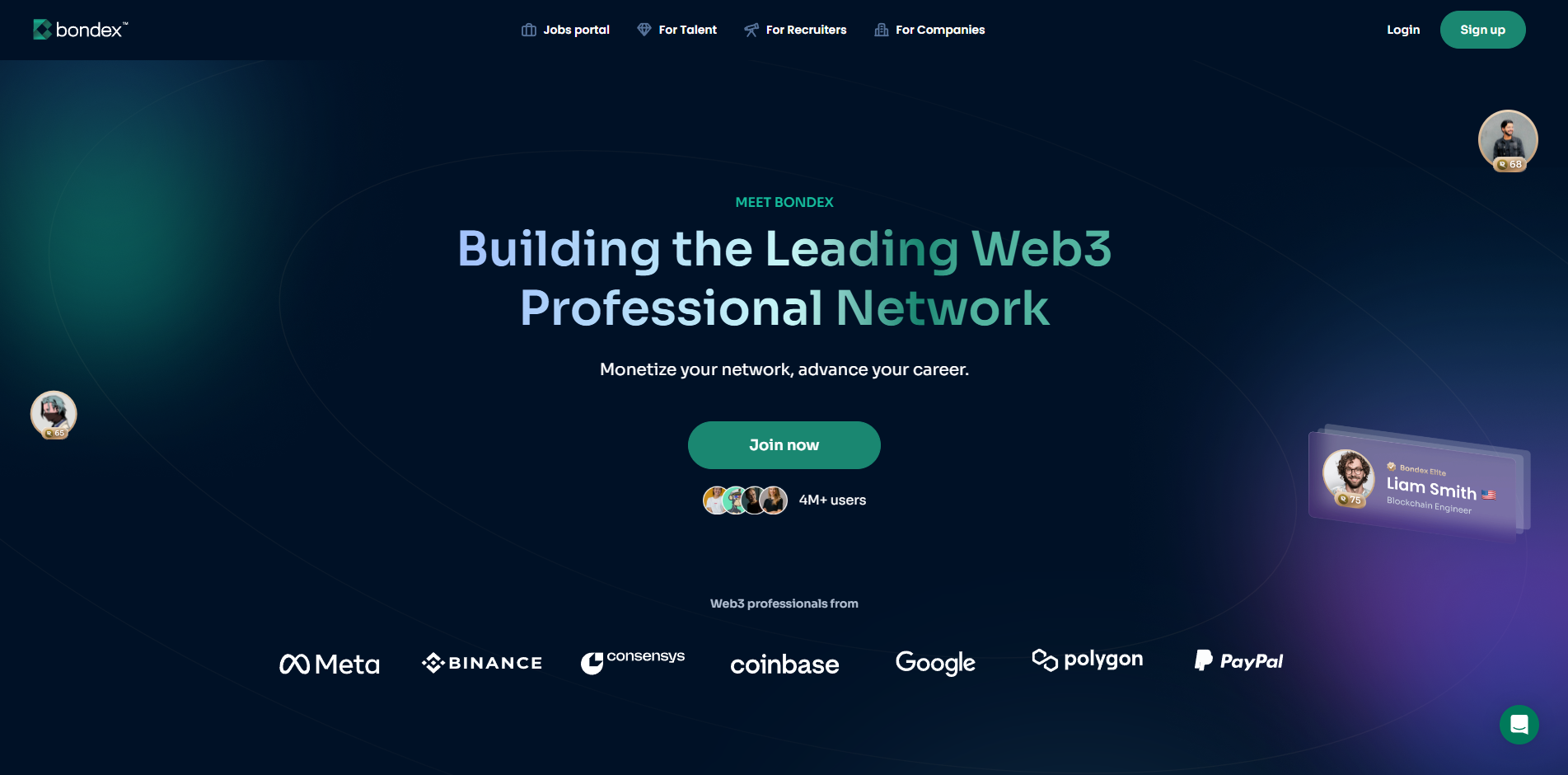
How’s everybody doing? This time around we are talking to Ignacio Palomera - CEO and co-founder of Bondex, a Web3-powered platform that is revolutionizing how professional trust and credibility are built and verified in the digital age.
Chris: Your journey started as an experiment. What did you initially set out to prove or learn, and how did the user response shape the trajectory toward Vision 2.0?
Palomera: The first and original idea for Bondex actually came seven years before the launch, when I left investment banking and joined a company called Expert Network as one of its earliest employees. As the Chief Strategy Officer, I was in charge of the blockchain side of things due to my expertise in the field. I came up with a token economic model to create a freelancer marketplace on-chain. That idea never left my mind. It was a company I had to build. I had to prove that I was right, and that we could enable peer-to-peer talent marketplaces and exchanges. I was still working in private equity but I launched Bondex as an experiment within the gamified mobile app which got a lot of traction and went extremely viral. This is what I mean by an experiment. However, incentive-based dApps do not work. It has been proven by airdrops and their lack of efficiency or their ineffectiveness at capturing real product-market fit and long-term users. Vision 2.0 came from two key insights after having a product, service, and mobile app in the wild with a critical mass of users and clients. Number one: you need to be solving real problem solutions, otherwise users come but they leave to chase the next incentives. In our case, we set out to fix talent exchange and enterprise services in Web3. The number two insight, which is even more important, is that displacing Web2 networks and platforms is a very tall order. The switching costs and network effect mode is too hard to overcome. Instead, what I focus on is the amount of noise that all of the data that were overwhelmed by, all of the noise that tools we currently use in both Web2 and Web3. So instead we use blockchain as a trust layer. We aggregate and bridge every platform you use today, and we use blockchain to verify those credentials and evolve a resume into a reputation score. A passport for the future of work.
Chris: How does Bondex define a 'professional' in the age of decentralization, and how are you accommodating non-traditional career paths in Web3?
Palomera: It's not just Web3 actually, careers and work are becoming increasingly fractional, and I think this is going to be accelerated by AI. Careers that used to last 4 or 5 years now last one year at a company, especially with Gen Z. The issue is that the talent infrastructure we're using (static resumes, static LinkedIn profiles, siloed Upwork profiles) does not communicate with each other. They're not interoperable across platforms. Not to mention the amount of lying that takes place in professional identities today. We believe digital reputation is a new resume and has to be a passport that travels with you across platforms so you can build your reputation across the internet in whatever way you're monetizing your time and skills. This is the vision for the Bondex ID, Reputation, Account and Identity, a comprehensive solution for the future of work.
Chris: Can you break down how the Bondex App, Job Portal, Bond Points system, and $BDXN token interconnect to create a self-sustaining economic and social loop?
Palomera: Absolutely. The way that we power our apps and platforms of services today are based on an off-chain premium currency. Think of it like a video game currency that you earn based on the more that you play, the more missions you complete or the value you create. These points can then be used to access services on the platform. But as of today, mobile apps do not allow tokenization. Only wallets and exchanges are able to realize dApps with tokenizations. The way it works is that there is an exchange rate between your point balance and our tokens, and it's not just driven by a points balance but also your scores and everything that you're able to accomplish that we track via the gamification in the app and our services. Once a user has added enough value and proven it via the gamification and reputation score, they're able to access our airdrop of tokens or they can buy them on the open market. Then there is a relationship between the revenue generated by the platform and the bond points and your reputation score. Our token is then distributed to both token holders and users, but it's gated because you have to be an active user of the platform. You cannot be expecting revenues or value from the work of others. You need to be contributing to the ecosystem. And in essence, the token is a valued redistribution mechanism, delivering on the true promise of Web3, which is sharing the revenue and empowering the users. Today, Web2 platforms are extremely extractive to the user. In fact, they're exploiting them for their data, which is more valuable than oil. With Bondex, you earn your points, build your reputation score, and that way you're able to earn tokens. We will redistribute the revenues from our products and services and eventually Web3 native advertising to our users, creating a positive flywheel that will trigger not just loyalty but also network effects.
Chris: What makes the upcoming Social Economic Network (SEN) the 'most advanced' — what core mechanics or innovations differentiate it from other web3 social platforms?
Palomera: OK, so what is a social economic network? This is the evolution beyond our Web3 LinkedIn killer. I no longer believe that we're going to displace LinkedIn. I believe that we're better off providing tools enabled by blockchain and AI to navigate existing professional networks and eventually become our own social economic network.
What that means is that in the future of work, social and professional opportunities will collide into one, and a reputation score represents a social credit score combined with your on-chain data and professional identity that will essentially enable you to access different types of economic opportunities to monetize your time, skills, and attention in a different way. This will enable a new kind of network, not just for the future of work, but to enable a trust-based economy vs the attention-based economy that we have today and that we all find extremely exhausting and ineffective.
Chris: Many Web3 platforms struggle to balance speculation and value creation. How does Bondex structure its incentives so that users are rewarded for meaningful contributions rather than hype-driven activity?
Palomera: This is the bane of my existence. The playbook in Web3 was all based around hype. It didn't matter whether you were an alt or a meme coin - it was predominantly all marketing based. This led to a lot of negative incentives in which a lot of project founders and projects raised a lot of money really easily and they never delivered on the products and services that they promised. Hype marketing is extremely important in the token launch, being able to capture enough attention that leads to liquidity, enabling you to build and execute on the vision of your company. However, the speculation multiple is now not as valuable as it used to be. You can see that in the performance of all the alt token launches that have happened in the last 12 months. The playbook has drastically changed and it's been handed down from the top down from VCs and exchanges who are now looking at fundamentals (which are revenue and profitability and product-market fit) more than ever. Essentially, the crypto industry is maturing into a more traditional venture and tech industry. I welcome this change, and we are built for this change. We solve real problem-solution sets and we generate real revenue by creating products and services that users and enterprise clients are willing to pay for. Because we have these fundamentals, yes, hyper-marketing and speculation are important in the short term, but if you don't have these fundamentals underpinning your project, you will not have longevity and you will not last long in the market.
Chris: The $10,000 referral bounties are eye-catching. How do you ensure this kind of aggressive growth mechanism doesn’t compromise quality control and spam resistance?
Palomera: Actually, we ensure that the aggressive growth mechanism doesn't compromise quality because we've developed an incredible AI filtering solution. We also have negative incentives if you use your bond points to nominate someone or vouch for someone for a job and they get ranked out of 1 to 5 stars by the AI. If they get completely disqualified because you've submitted, let's say, a hairdresser to a software engineering job, you're going to have a penalty for being a bad recruiter.
Meanwhile, if you've recommended someone that is highly regarded by the AI, you will be able to earn additional points. We believe that machine and human is the best combination, especially when it comes to talent. You still need the human touch.
So after we do the AI filtering, we shortlist the list of candidates. Actually, we have a team of very talented talent operations that does a quality assurance and security check before we present those clients before we present those candidates to the client.
And that's essentially how you filter for speculation or aggressive growth via incentives and quality to the client. Because at the end of the day, what we're trying to do is serve them the same level of quality of talent that they're used to from a traditional agency or platform, actually even better than a platform, at a fraction of the cost and time. And we do this via blockchain verifications of credentials along with really great AI filtering. Along with experienced recruiters and their Talent Operations team, this is the perfect combination to disrupt the traditional Talent Agency model.
Chris: Bondex promotes the idea of 'digital reputation as currency'—how is that reputation earned, stored, and measured? Is it fully portable across platforms?
Palomera: We say two things here:
- Reputation - digital reputation is the new resume.
- Your reputation is your currency, and that will help you actually gain visibility across all the noise that you have in talent and professional networking.
The other thing we like to say is that your network is your net worth. And what we are enabling through this infrastructure is for people to build verified digital reputations by verifying several things: whether their identity as a human, their professional capabilities, their social networks, and their on-chain activities. All via CK oracles which are preserving their privacy. We've only recently built all this great infrastructure and have now reached a critical mass of users. But we're only using it for two utilities that we've built in-house:
- CRM for networking and business development
- Talent exchange via our two job portals: Web3 Careers and Bondex Jobs
The next step is to bring more and more utility to our reputation score. That's why we're going to make the Bondex profile and ID something that users can log into different dApps with. We already are partnering with other talent providers that I will not name here (like talent agencies) to be able to use our profiles because they have that verified credentials and reputation, solving a huge pain point of KYC on location and really knowing that someone is not just who they say they are but also that they're able to do the skills that they claim they have, or for example, that they worked where they claim they worked.
Chris: You mention that most Web3 social platforms fall short due to poor UX and high barriers to entry. How does Bondex tackle onboarding for non-crypto-native professionals?
Palomera: It's actually not just poor user experience which is an issue across consumer apps in web3. We believe that web2.5 is the way to go, meaning that you have an easy-to-use platform with blockchain and its complexities abstracted from the user experience while offering the benefits of the technology. The way we do it is with a Web2.5 playbook, meaning a perfect bridge to onboard any user whether they're Web2.5, Web3, or degens. Something that is easy to use and intuitive without blockchain being an impediment.
Chris: As Bondex evolves from a Web2.5 foundation to a fully decentralized ecosystem, what are the core milestones you're most excited about over the next 12–18 months?
Palomera: Our playbook is to build services and products using Web2 technology that solve real problems and are usable. After our TGE, the beginning of our implementation of tokenisation begins. The beginning was to enable on-chain features via our verifications using blockchain to verify credentials in a professional identity setting. The long-term roadmap to become more and more decentralized begins post-TGE, once the DAO is structured and the token begins to have governance properties. In this phase, you progressively become more and more self-sustainable from a governance perspective by enabling and empowering the users to take part in the direction that the platform takes. However, you do not begin fully decentralized. In order to get to Web3, we need to go through Web2.5 first.





 usdt
usdt xrp
xrp

